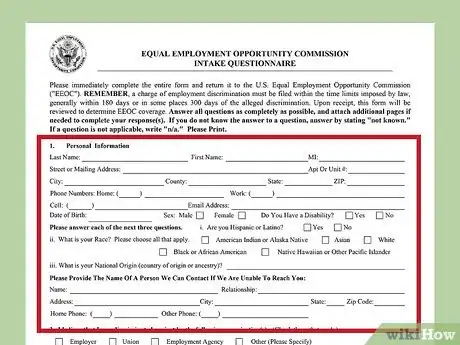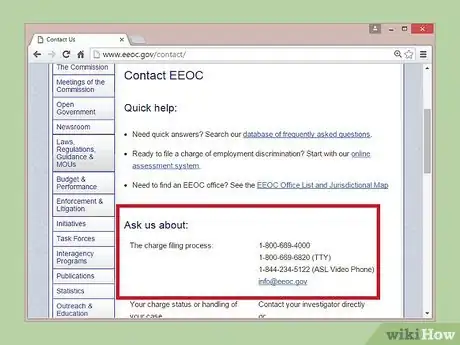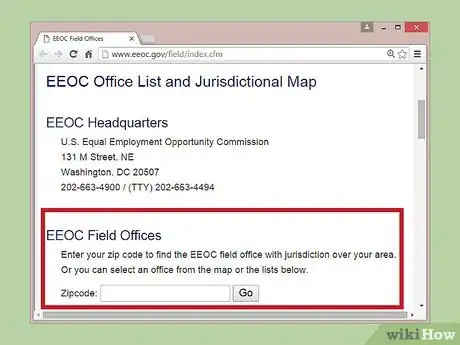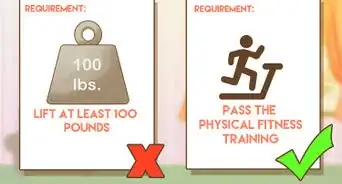This article was written by Jennifer Mueller, JD. Jennifer Mueller is an in-house legal expert at wikiHow. Jennifer reviews, fact-checks, and evaluates wikiHow's legal content to ensure thoroughness and accuracy. She received her JD from Indiana University Maurer School of Law in 2006.
This article has been viewed 42,627 times.
The U.S. Equal Employment Opportunity Commission enforces federal laws prohibiting employment discrimination. Maybe you are an employer seeking information on compliance with the laws or training materials for your staff, or maybe you are an employee who thinks you're being discriminated against because your manager is harassing you, or maybe you're just a member of the general public who wants to know more about the work the EEOC does – regardless of your reason, there are several ways to contact the EEOC and get the information you need.
Steps
Using EEOC Resources Online
-
1Visit the EEOC's main website. No matter what your reason for wanting to contact the EEOC, you can get a good start at finding the information you need by going to http://www.eeoc.gov/.
- The home page includes links to information for employees, employers, and federal agencies.
- There are also a number of pages listed that tell you how to do specific things, such as how to find help for small businesses or how to file a charge of employment discrimination.
- If you just want to find out the latest in employment discrimination news, you can check out the EEOC's "Newsroom."[1]
-
2Check the database of frequently asked questions. The EEOC maintains a list of frequently asked questions, which also can be a good starting point to find information.
- You can type in your own question and search the database, or browse through the list and read questions that interest you.[2]
Advertisement -
3Research types of discrimination and the laws enforced by the EEOC. The EEOC's website includes detailed information about every type of employment discrimination covered by the laws the EEOC enforces, including racial and religious discrimination.
- Generally, the EEOC enforces federal laws that prohibit discrimination or unfair treatment because of your race, color, religion, sex, pregnancy, national origin, age, disability, or genetic information. Age discrimination only applies if you are over 40.
- If you believe you have been discriminated against at work, you must file a discrimination charge with the EEOC before you can file a lawsuit against your employer.
- The EEOC website explains how much time you have to file a charge, whether your employer is covered, whether you're protected under the laws the EEOC enforces, and what the charge filing and investigation process is like.[3]
-
4Use the online assessment system. If you think you may want to file an employment discrimination claim against your employer, you can start the process online.
- Although the EEOC does not accept charges online, the online assessment tool can help you determine if you should be using the EEOC or some other agency.
- If you decide to file a charge, you can print an Intake Questionnaire. Once you've filled it out, you can either mail it or take it with you to your nearest field office to begin the process of filing your charge.[4]
Contacting the EEOC by Phone or Email
-
1Decide what kind of information you need. The EEOC has a contact page with several different phone numbers and email addresses you can use, depending on why you want to get in touch with the EEOC.
- If you can't decide what category your inquiry would fall under, you can call the main toll-free number at 1-800-669-4000 or email info@eeoc.gov.
- Some requests don't require direct contact. For example, if you are an employer looking for an EEOC poster or other EEOC publications, there are links on the website you can use to print posters to hang in your office.
-
2Call or email for more information. The EEOC does not accept discrimination charges this way, but you can use the national toll-free numbers and email addresses to get more information or to discuss the process.
- If you call the toll-free number and want to file a charge, the operator will take down your information and forward it to the appropriate EEOC field office to assist you further.[5]
-
3Call your local field office. If you don't want to call a toll-free number, you can also find your local field office on the EEOC's map. Pull up the office information and call the local number instead of the national toll-free number.[6]
Contacting the EEOC by Mail
-
1Find the address of your local field office. On the EEOC office list page, enter your zip code or browse the list of field offices to find the EEOC field office closest to you.[7]
- You can use the mail to begin the process of filing an employment discrimination charge. For any other request, you should consider calling first to ensure your request is handled promptly.
-
2Write your letter with the required information. To file a charge of employment discrimination by mail, simply send a letter which includes your name, address, and telephone number; the name, address, and telephone number of your employer; the approximate number of employees who work there; and a short description of what happened that you believe was discriminatory, when it happened, and how you believe the act discriminated against you.[8]
-
3Sign your letter. Once you've written down all the required information, sign it. The EEOC cannot investigate your charge unless it includes your signature.[9]
-
4
Visiting an EEOC Field Office in Person
-
1Go to the EEOC Field Office map. The EEOC's website includes a page where field offices can be located either by looking at the map or browsing a list.[12]
-
2Enter your zip code or choose an office from the list. On the EEOC office list page, you can find the office closest to you by typing your zip code and clicking "Go." You will be redirected to the office information page of your closest field office.
- You also can look at the map and browse the list of offices below it to find your nearest office. Each of the offices is linked.
- The EEOC has 15 districts with a number of area, local, or field offices under them depending on the population of the district. For example, the Birmingham, Alabama district office covers the states of Alabama and Mississippi, and the Florida Panhandle. In addition to the district office, there is an area office in Jackson, Mississippi and a local office in Mobile, Alabama.[13]
-
3Review the office information. Once you find the office nearest you, the office information page provides you with the address, phone and fax numbers of that particular office, as well as its hours of operation and when it takes walk-ins for intake evaluation.
- For example, if you live in Nashville, Tennessee, you would file your charge in the Nashville area office. That office is open from 8:00 a.m. until 4:30 p.m. Monday through Friday, but only takes walk-ins through 2:00 p.m. Monday through Thursday and through 12:00 noon on Friday.
- You can either appear at the office as a walk-in, or call and schedule an appointment for an interview.
References
- ↑ http://eeoc.gov
- ↑ https://eeoc.custhelp.com/app/answers/list
- ↑ http://eeoc.gov/employees/
- ↑ http://eeoc.gov/employees/howtofile.cfm
- ↑ http://www.eeoc.gov/employees/howtofile.cfm
- ↑ http://www.eeoc.gov/field/index.cfm
- ↑ http://www.eeoc.gov/field/index.cfm
- ↑ http://www.eeoc.gov/employees/howtofile.cfm
- ↑ http://www.eeoc.gov/employees/howtofile.cfm














-Step-24.webp)
















-Step-24.webp)





































